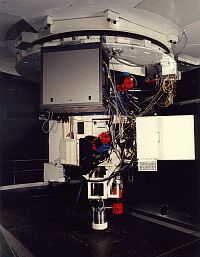First light (at ING): October 1987.
De-commissioned: January 1998.
Designed and built by: Durham University and Royal Greenwich Observatory.
Description:
The FOS is a collimator-less dedicated (not versatile) spectrograph designed to have the utmost efficiency for use at low dispersion and covering the widest possible wavelength range. It employs a transmission grating whose substrate is cemented onto a cross-dispersing prism which in turn is cemented onto the aspheric plate of a Schmidt-type camera, so eliminating four glass-air surfaces. The grating lies in the divergent beam from the ISIS slit assembly when the straight-through mode is selected. The resultant complicated aberrations are satisfactorily corrected by appropiate adjustments in the separation, tilt and centering of the rest of the components of the system. A CCD detector is mounted on a cooled finger which supports it at the internal focus of the Schmidt-type camera so avoiding the need for a further reflecting surface to provide an external focus as for the ISIS cameras. A similar spectrograph, built jointly by the RGO and Durham University, is operating on the Isaac Newton Telescope. The troughput of the optical system is similar to that of the INT FOS, that is about 70% at the peak of the grating blaze.
Time allocations:
Nights scheduled since semester 2007B
Research impact:
Scientific highlights (9)
Publications (67 from ING paper count)
Multimedia:
Photo archive (8)
Video archive (1)



